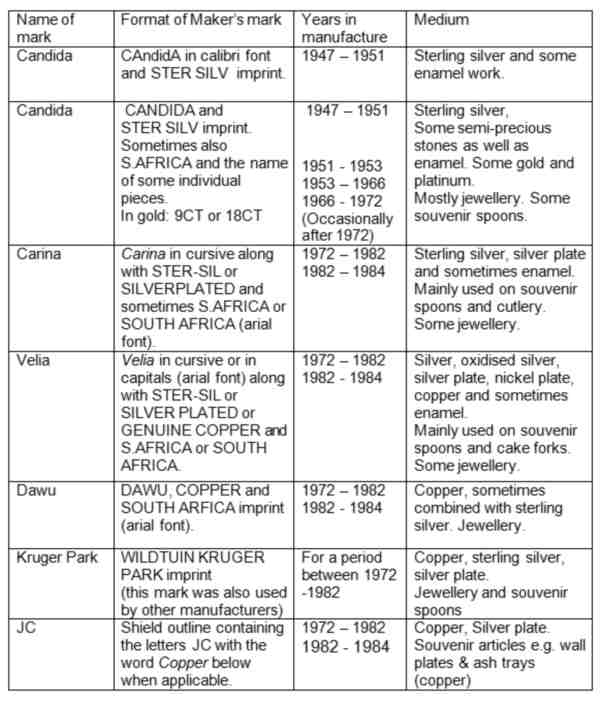(click on photos to enlarge image)
JOE CALAFATO: A SOUTH AFRICAN CREATIVE JEWELLER AND
SILVERSMITH
(ACTIVE 1947-1984)
Joe Calafato designed and manufactured silver
jewellery, flatware and hollowware during the mid to
late 20th century in a career spanning 37 years in
Pretoria, South Africa. His work made an important
contribution to the development of a uniquely South
African design domain and has become increasingly
sought after at antique and collectible markets.
Of Sicilian parentage, Giuseppe Leonardo Calafato
was born on the 10th of July 1912 in the then
Lorenço Marques (now Maputo) Mozambique. In the
1920s the family moved to Johannesburg. Here he did
his apprenticeship as a manufacturing jeweller under
Jack Friedman - a well known local jewellery
manufacturer of his time.
From April 1938 until June 1945, Joe worked for the
South African Mint in the capacity of Jeweller and
Silversmith in the Medal and Badge Department.
(see note 1)He was particularly
interested in the designing and making of medals.
(see note 2)
After the Second World War he resigned in 1947 and
ventured into business, first with a number of
partners and eventually on his own. He became a
prolific designer and employed a number of die
sinkers, solderers, enamellists and engravers in his
workshops. He sold his business in 1984 and, after a
long battle with cancer of the esophagus, the South
African 'King of Silver',
(see note 3) Joe Calafato died in 1991 at
the age of 79.
(see note 4)
|
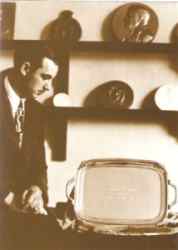
|
| . |
Early 1960s: Joe Calafato
with a silver presentation tray
|
During his career as independent creative silversmith, he
made use of various maker's marks. He started using the name
'Candida' as his first maker's mark (1947-1972), after which he
switched to a number of marks, namely 'Carina, Velia, JC, Dawu
and Joe Calafato'.

Candida marks used during different time periods
(see Table 1)
|
Some souvenir spoons contain both the Carina and Kruger Park
marks or the Velia and Kruger Park marks. Some copper souvenirs
also contain both the JC and the Kruger Park marks. This
indicates that some of his merchandise was sold to the Kruger
Park. This was produced during the broad period of 1972 -1984. A
more definitive timeline could not be determined.
(see note 5)
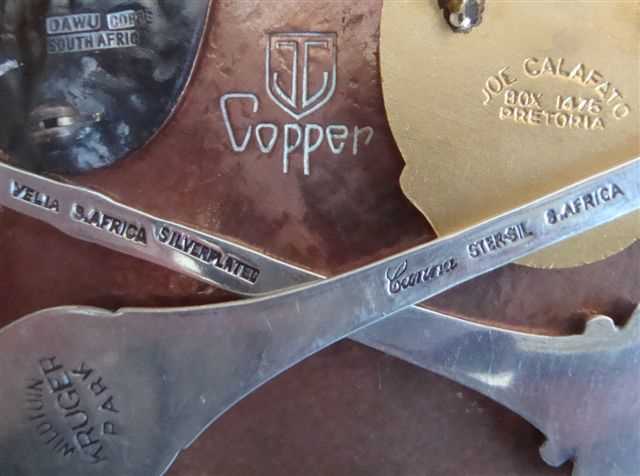
Different maker's marks used by Calafato (see
Table 1)
|
In Table 1 a summary is provided of the maker's marks used
during his career. It is not clear why such a range of marks
were used - perhaps in order to distinguish to some extent
between his copper work and silver work as well as to
distinguish between his badge work, silver ware for the tourist
market and his more sophisticated jewellery work.
(see note 6). No one of his maker's marks was
registered with the South African Companies and Intellectual
Property Registration Office.
(see note 7)
Table 1: Maker's marks used by Joe Calafato
Manufacturing processes, materials and range of composition
He used mainly two processes for producing his jewellery - a
so-called 'press method' and a 'die cast method'.
(see note 8)
The press method included the use of a weighted press on a flat
bed of metal overlaying a die consisting of hardened steel. With
this method the die sinker could produce fine detail such as
relief and scroll work that gets chiselled from the steel die
before it is hardened.
(see note 9)
In the die cast method a rubber mould, wax, plaster of Paris and
a centrifugal force to properly distribute the molten metal in
the mould, were used.
(see note 10) Chalices, cups and vases were hammered,
hard cast as well as lathe spun.
(see note 11)
His jewellery designs consisted of individual pieces and any
combination of bracelets, bangles, rings, brooches, pendants,
necklaces and earrings. He worked mostly in sterling silver and
copper but also made use of silver plate, some gold, platinum
and enamel where he primarily used the cloisonné technique.
Sometimes precious and semi-precious stones were also included
in the compositions.
(see note 12)
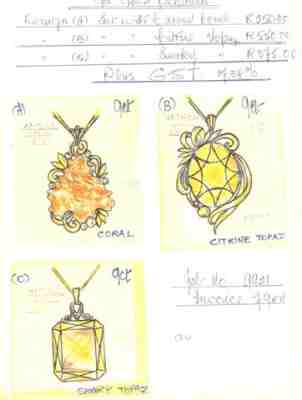
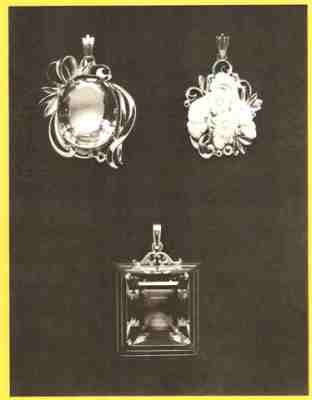
Silver pendants containing coral, citrine and
smoky topaz
|
Demonstrating a professional standard of craftsmanship, his
creations over the years displayed a fairly diverse range of
styles - for example shifting from lyrical baroque designs to
playful and romanticised human figures to minimalist abstract
forms. Especially the bold and chunky designs of some of the
ensemble pieces are well known. Some brooches, pendants and
earrings were designed with movable parts, allowing the pieces
to echo the wearer's movement.
(see note 13)
Calafato did not only manufacture jewellery. Throughout his
career, he diversified his output to include all kinds of metal
artwork. He also specialised in enameled, badges, service awards,
sporting spoons, reliquaries, shields, trophies, presentation
keys and trowels as well as regalia (such as mayoral chains).
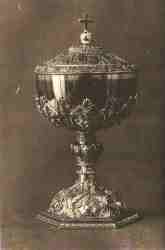
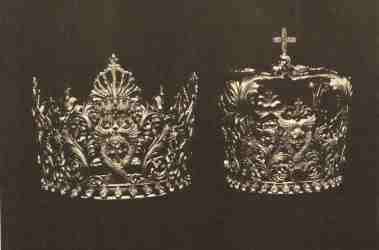
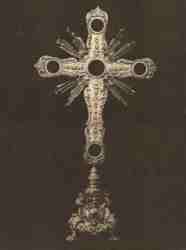
Sterling silver liturgical objects by Joe
Calafato, circa late 1950s
|
Flatware that included cake forks, tea spoons, sugar spoons
and (commemorative) serving trays, were adorned with scrolls,
small Proteas and animals on the spoon finials. They were made
in silver or silver plate under the Carina and Velia insignia.
The animal crests captured images of giraffe, elephant, water
buck, kudu and impala. The spoons were also sold as souvenir
singles. The animal sets were marked with the Velia, Carina and
Kruger Park Maker's marks.
(see note 14) Some demitasse spoons were also
manufactured.
He used enamel to create coats of arms representing a range of
South African cities on the handles of souvenir tea spoons.
These include the cities of Pretoria, Johannesburg, Cape Town
and Durban. Six different colours of enamel were used for the
colouring of the crests; yellow, black, white, red, brown and
green. He used his wife's name Velia as well as the Carina and
earlier Candida marks on the spoons.
(see note 15) Some contained African village life or
African wildlife scenes in the hollow of the spoons. The high
quality and refined three-dimensional artistry on the hollows,
hilts and finials of the spoons, reflected the custom of a
discerning clientele.
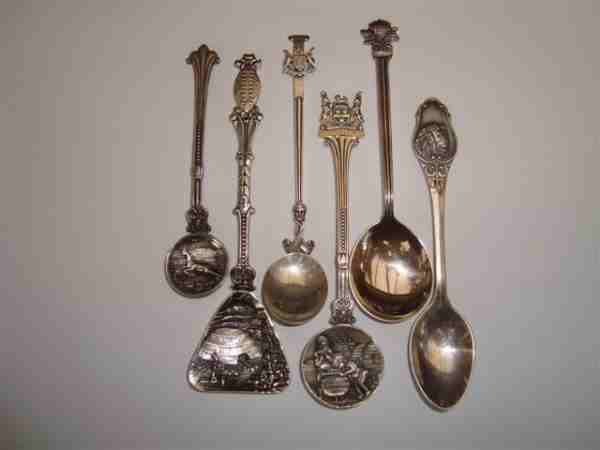
Sterling silver spoons made under the 'Candida'
and 'Carina' marks late 1960s to early 1970s
|
Under the Dawu mark he seems to have specialised in copper
brooches and bracelets that focus specifically on African
cultural themes.
Influences and thematic content
Calafato mixed and redesigned dies and patterns throughout
his career. In the beginning, components such as scroll patterns,
round balls, small smooth half drops as well as riffled hollow
cups (possibly influenced by European trends) were often
reconfigured and soldered together in different designs. Later
on, his inspirations shifted to African and wildlife images that
were also recombined in different pieces of jewellery.
(see note 16)
His preferred medium was silver which was already well
established as a popular jewellery base in the Arts and Crafts
movement of the late 19th century. Also, a number of the early
Candida artifacts reflect the use of 'cabochon' cut (a rounded
or oval cut with a flat base) semi-precious stones set in silver
as well as the use of enameling which was introduced during this
time.
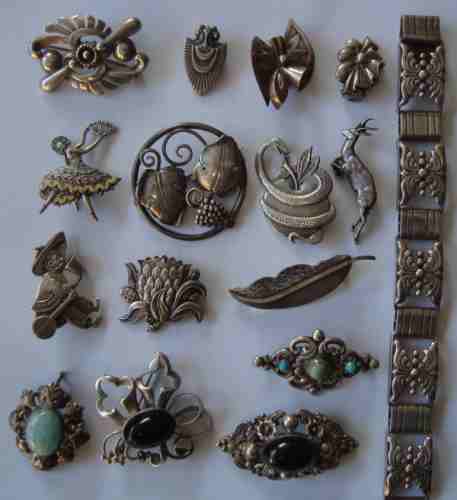
Examples of early work done under the 'Candida'
mark
|
African themes formed an important line in the Candida
collection, and the attention that African art received from
Europe during the Art Deco period (1920-1939) resulted already
then in African inspired designs manifesting in jewellery.
Interestingly, the African compositions with the Candida and the
later Velia, Carina and Dawu maker's marks seem to be made only
as separate brooches, pendants, bracelets and earrings but not
in the form of necklaces or ensemble pieces.
(see note 17)
Perhaps understandably, the dominant movement during the 1940s (recently
differentiated as the '1940s retro' style or 'retro moderne')
(see note 18) appears to have played a significant
inspirational role during the first phase of jewellery
manufacturing. Typical of the time, stark geometric shapes were
combined with swirling and draped forms: loops and tendrils of
metal "ribbon" scrolls, pleats, folds and ruffles in large and
dramatic pieces. Also, the hammered surfaces on some bon-bon
dishes that were created in the 1950s reflect this period well.
(see note 19)
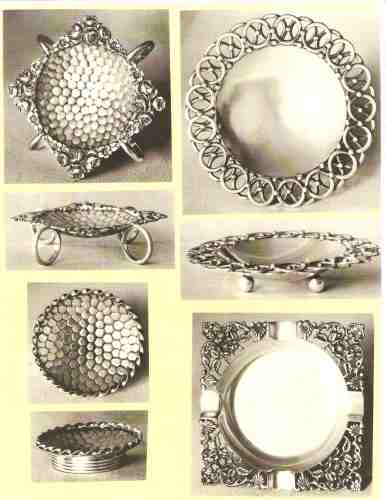
Examples of die casting and hammered work
stemming from the 1950s
|
In the 1940s and 1950s the use of wire to lighten items of
jewellery and give texture to surfaces (introduced during the
Arts and Crafts movement)
(see note 20) was again picked up and popularised by
European manufacturers.
(see note 21) Similarly, the use of wirework was also
successfully incorporated as a design element in the early
Candida designs (he did not however produce filigree work).
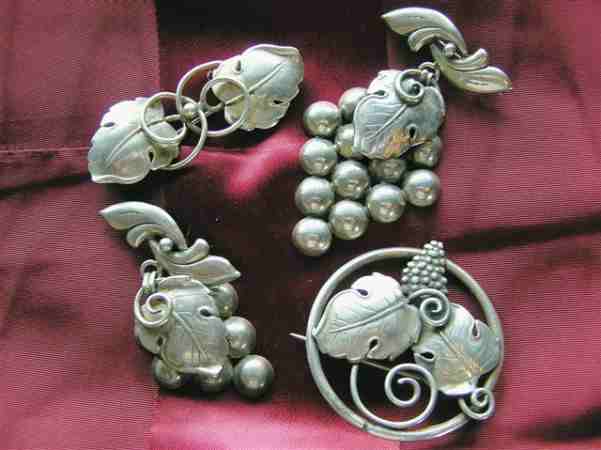
Early 'Candida' marked designs in which
combinations of cups and leafs are combined with
wirework.
|
During this time, international jewellery houses such as
Cartier, Tiffany and Van Cleef & Arpels began producing their
versions of popular figurative motifs: animals, ballerinas and "novelty"
figures such as clowns, scarecrows and flower-sellers.
(see note 22) This line of inspiration was also
expressed by a wide range of Candida figurines in the form of
brooches. Jewellery was increasingly seen as an art form in its
own right, not just as a fashion accessory, with precious metals
being used for their intrinsic beauty and not only for mounting
gemstones.
(see note 23)
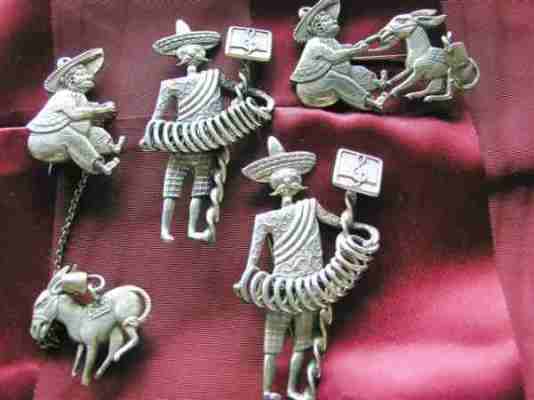
Silver figurine brooches based on a Mexican
motif
|
In the midst of the proliferation of styles in the 1960s and
1970s, there was, however, also a trend towards the kind of "organic
modernism" stimulated by Scandinavian designers with many
designers striving for an economy of line and form.
(see note 24) This trend can also be detected in some
of the later designs under the Candida mark as well as the range
of work he produced under the Carina and Velia marks.
(see note 25)
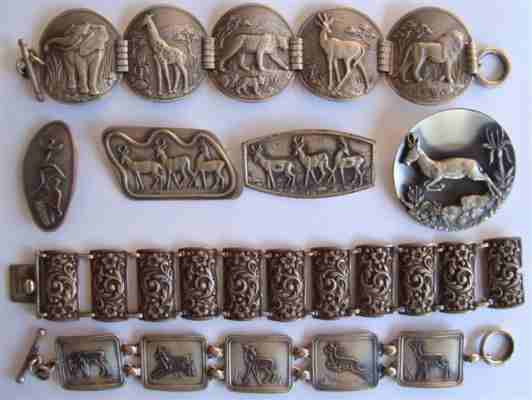
Examples of work done under the 'Velia' and
'Carina' marks
|
His work reflects a time line in terms of a fading European
influence mingling with a strengthening African influence both
in terms of inspiration and form. There is a clear migration
from the original scroll abstractions to a more 'organic realism'
in expressing plant, animal and human form, ending in an almost
exclusive emphasis on African landscape, animal and village
life.
(see note 26) At the end, his work matured into
extensively embracing images of the African continent, making
him a truly African manufacturing jeweller in the full sense of
the word.
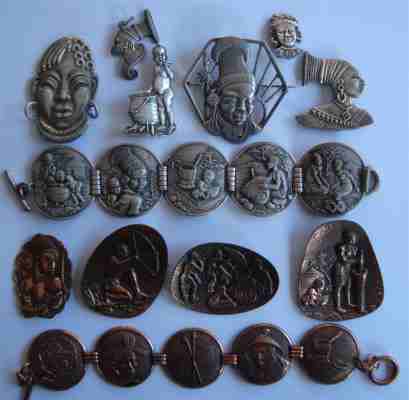
African studies in sterling and oxidized silver
and copper by Joe Calafato
|
Conclusion
Joe Calafato possessed a unique combination of skills with
which he contributed significantly to our South African cultural
heritage. Not only was he a successful businessman and employer,
but he also shared his talents and experience as an artist and a
craftsman with many others. His legacy does South Africans proud.
The above is a synopsis of Calafato's creative contributions to
a South African cultural legacy in silver. A more extensive
account has been posted on www.goldsmiths.org.za.
note 1: Juwelier maak nou medaljes, Hoofstad,
1982-10-27, p.6.
note 2: Testimonial issued by the South African Mint on
13 July 1945 upon Joe&s resignation.
note 3: Interviews: Mr. L. Scribante, Pretoria,
2005-20-31 and 2005-11-09.
note 4: F. van Staden , Joe Calafato: The story of a
South African fine metal artist, Reflections of Yesteryear 2(3),
2001, pp. 13-17. Follow up interview: Ms. Z. Calafato, Pretoria,
2004-11-17.
note 5: Examples from the Van Staden collection.
note 6: Juwelier maak nou medaljes, Hoofstad, 1982-10-27,
p.6.
note 7: A search by the national Registration Office back
to 1943 yielded no information. http://ipnewpto/zaptolemy/web/IP/trademark/tmapplication/list.aspx,
2009-04-15.
note 8: J. Bace, Collecting silver: The facts at your
fingertips (London, 2000), pp. 41& 43.
note 9: Juwelier maak nou medaljes, Hoofstad, 1982-10-27,
p.6.
note 10: F. van Staden , Joe Calafato: The story of a
South African fine metal artist, Reflections of Yesteryear 2(3),
2001, pp. 13-17.
note 11: Interviews: Mr. L. Scribante, Pretoria,
2005-20-31 and 2005-11-09.
note 12: Interviews: Ms. Z. Calafato, Pretoria,
2004-11-17 and Mr. L. Scribante, Pretoria, 2005-20-31 and
2005-11-09. Designs recorded in Calafato's sketch book.
note 13: Examples from the collections of Z. Calafato, S.
Schultze I. Swart and F. van Staden. Combined, their collections
hold more than 400 individual pieces of jewellery, as well as
other artifacts produced by Joe Calafato. Also, interviews: Mr.
G. Xanthides, Pretoria, 2004-11-16 and 2004-11-17.
note 14: Examples in the Calafato and Van Staden
collections.
note 15: Examples in the Calafato and Van Staden
collections.
note 16: Examples in the Calafato, Swart, Schultze and
Van Staden collections. Also, the designs recorded in Calafato's
sketch book
note 17: Examples in the Calafato, Swart, Schultze and
Van Staden collections. Also, the designs recorded in Calafato's
sketch book.
note 18: Retro moderne designer notes,
http://www.emcity.com/refretro.htm, 2009-08-14.
note 19: Examples in the Calafato, Swart,Schultze and Van
Staden collections. Also, the designs recorded in Calafato's
sketch book.
note 20: J. Bace, Collecting silver: The facts at your
fingertips (London, 2000), p. 86.
note 21: History of wire crafted jewelry,
http://www.witswires.com/page/1079975, 2009-08- 14.
note 22: J. Price, Masterpieces of American jewelry, pp.
80, 89-92.
note 23: Examples in the Calafato, Swart, Schultze and
Van Staden collections.
note 24: C. Truman (ed.), Sotheby's concise encyclopedia
of silver, pp. 182-183.
note 25: Examples in the Calafato, Swart, Schultze and
Van Staden collections.
note 26: Comparing outputs before 1972 in the Calafato,
Swart, Schultze and Van Staden collections to the outputs after
1972.
Fred van Staden
Department of Psychology, University of South Africa,
PO Box 392, Pretoria, 0003 E-mail: fvanstaden@mweb.co.za
- 2014 -
|
|




